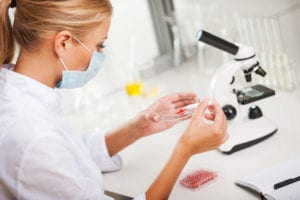Written by Joyce Smith, BS. Study demonstrated that hospital toilets may be heavily contaminated with pathogenic bacteria such as Clostridioides difficile which could contribute to environmental contamination in patients’ rooms.
 Flushing uncovered toilets is a potential source of environmental contamination with pathogenic bioaerosols like C. difficile in hospitals and other health care settings. This gram-positive, anaerobic, spore-forming bacteria that sheds from the gastrointestinal tract, 1 persists in the environment, affects almost half a million people and claims almost 15,000 deaths annually in the United States 2. C. difficile, when encapsulated into highly compact and penetration –resistant spores, persist in the environment for extended periods of time, allowing them to survive in a toilet bowel. When toilets are flushed, the aerosol droplets produced can mix with the air of the room, allowing larger droplets to settle on a surface before they dry, contaminating surfaces such as the toilet seat and handle, and finally contaminating the hands that touch them. In one study researchers validated that spores could contaminate a hospital room when they were able to isolate the spores on toilets, bedsheets, bedpans, washbasins, bed rails, floors, and walls of rooms occupied by patients with CDI 3. C. difficle can colonize readily in patients with intestinal dysbiosis and support the growth of other intestinal pathogens such as hospital-acquired Enterococcus faecalis and faecium infections 4.
Flushing uncovered toilets is a potential source of environmental contamination with pathogenic bioaerosols like C. difficile in hospitals and other health care settings. This gram-positive, anaerobic, spore-forming bacteria that sheds from the gastrointestinal tract, 1 persists in the environment, affects almost half a million people and claims almost 15,000 deaths annually in the United States 2. C. difficile, when encapsulated into highly compact and penetration –resistant spores, persist in the environment for extended periods of time, allowing them to survive in a toilet bowel. When toilets are flushed, the aerosol droplets produced can mix with the air of the room, allowing larger droplets to settle on a surface before they dry, contaminating surfaces such as the toilet seat and handle, and finally contaminating the hands that touch them. In one study researchers validated that spores could contaminate a hospital room when they were able to isolate the spores on toilets, bedsheets, bedpans, washbasins, bed rails, floors, and walls of rooms occupied by patients with CDI 3. C. difficle can colonize readily in patients with intestinal dysbiosis and support the growth of other intestinal pathogens such as hospital-acquired Enterococcus faecalis and faecium infections 4.
In this current study, Wilson and colleagues 5 examined the extent to which toilet flushing increased bioaerosol production and particle concentration from the toilet plumes in the bathrooms of CID infected patients in the University of Iowa Hospitals and Clinics. They collected bioaerosols on plates placed 0.15 meters (m), 0.5 m, and 1.0 m from the rims of toilets in 24 patient rooms and collected bathroom air continuously for 20 minutes with a bioaerosol sampler before and after toilet flushing. Focusing specifically on anaerobes like C. difficile, they then incubated the cultured plates in an anaerobic chamber, identified bacteria growth, measured bacterial density on the plates, and calculated the difference in bioaerosol production before and after flushing.
Bacterial cultures were positive in eight (33%) of the 24 of hospital rooms which yielded growth on at least one of the six plates collected from each bathroom during aerosol sampling. Average relative humidity was also higher in the rooms that yielded a positive culture; however, not significantly higher. Overall, nine of the 72 (12.5%) preflush samples and 19 (26.4%) of the 72 postflush samples tested positively for health care-associated bacteria, the predominant species including Enterococcus faecalis, Enterococcus faecium and C. difficile. Postflush samples had a significantly higher probability of culturing positive than preflush samples P = .0309) and demonstrated significant increases in concentrations of the two large particle size categories when compared with preflush samples (10 micrometers, P = .0082; and 5 micrometers, P = .0095).
Limitations included the pilot study and limited sample size, several rooms not being sampled because of patient objection, the exclusion of heavily contaminated toilets in rooms where patients had excessive diarrhea, and the inability of the anaerobic incubating chamber to support the growth and detection of aerobic pathogens such as Escherichia coli.
Researchers recommend the implementation of preventative measures such as the use of toilet lids to eliminate any hospital room contamination that might occur as a result of toilet flushing.
Source: Wilson, Geneva M., Virgil B. Jackson, Linda D. Boyken, Marin L. Schweizer, Daniel J. Diekema, Christine A. Petersen, Patrick J. Breheny, Matthew W. Nonnenmann, Eli N. Perencevich, and CDC Prevention Epicenter Program. “Bioaerosols generated from toilet flushing in rooms of patients with Clostridioides difficile infection.” Infection Control & Hospital Epidemiology (2020): 1-5.
© 2020 by The Society for Healthcare Epidemiology of America.
Posted April 22, 2020.
Joyce Smith, BS, is a degreed laboratory technologist. She received her bachelor of arts with a major in Chemistry and a minor in Biology from the University of Saskatchewan and her internship through the University of Saskatchewan College of Medicine and the Royal University Hospital in Saskatoon, Saskatchewan. She currently resides in Bloomingdale, IL.
References:
- Janezic S, Rupnik M. Genomic diversity of Clostridium difficile strains. Research in microbiology. 2015;166(4):353-360.
- CDC. Nearly half a million Americans suffer from C. difficile infections in single year. 2015; https://www.cdc.gov/hai/dpks/deadly-diarrhea/dpk-deadly-diarrhea.html. Accessed April 14, 2020.
- Fekety R, Kim KH, Brown D, Batts DH, Cudmore M, Silva J, Jr. Epidemiology of antibiotic-associated colitis; isolation of Clostridium difficile from the hospital environment. Am J Med. 1981;70(4):906-908.
- Fisher K, Phillips C. The ecology, epidemiology and virulence of Enterococcus. Microbiology. 2009;155(Pt 6):1749-1757.
- Wilson GM, Jackson VB, Boyken LD, et al. Bioaerosols generated from toilet flushing in rooms of patients with Clostridioides difficile infection. Infection control and hospital epidemiology. 2020:1-5.
